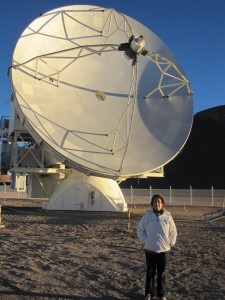News
Chilean astronomers identify the presence of smog in dwarf galaxy
Published 11-04-2013
• This pioneering discovery contributes to a greater understanding of how stars were formed in the Big Bang and was published in the renowned scientific journal "Nature".
• The research was funded by CONICYT and also one of the researchers currently pursuing his doctorate in astronomy thanks to a grant from the institution and the CNRS of France.
Smog in a galaxy?? Although it sounds incredible is a reality and is part of discovery made by two Chilean astronomers and allow experts to understand how low-metallicity galaxies, ie with small amounts of chemical elements like carbon and oxygen, fail to form stars.
This discovery was made by Dr. Monica Rubio, academic Department of Astronomy (THE) University of Chile and also adviser to the Astronomy Program CONICYT, by the then master's student DAS, Celia Verdugo, who is currently pursuing a Ph.D. in Astronomy in France thanks to a grant from the institution and the CNRS de Francia.
In the study “Carbon monoxide in clouds at low metallicity in the dwarf irregular galaxy WLM”, posted 27 by Marzo in prestigiosa Revista Nature, astronomers unveiled the detection of carbon monoxide molecules (CO) in the irregular galaxy WLM eDNI, using APEX telescope (Atacama Pathfinder Experiment) located 5.100 meters, on the Chajnantor plateau, Antofagasta Region.
La Dra. Rubio explains that the detected CO molecule is the same that makes up the smog of Santiago and the importance of their finding is that "no carbon monoxide do not know if there is molecular hydrogen, which is indispensable for the formation of stars in galaxies like ours or similar ".
The expert adds that "in our galaxy, the Milky Way, star formation occurs when interstellar gas condenses until stars are born ". For that to happen, the gas must be cooled and for this purpose the presence of elements such as oxygen and carbon is necessary. "When there is more abundance of molecules of carbon monoxide is lower temperature, gas is more dense and can form molecules. In the Big Bang these elements were not, therefore had an uncertainty of how galaxies formed such extreme conditions Stars ", adds.
The researcher pointed out that understanding the process by which new stars are born "is critical to understanding the evolution of the universe. Whenever we doubt if these galaxies had or not CO, because they had very low amount of ingredients or because we did not have the right instruments to detect, APEX but we did ".
From this year the observations of the irregular galaxy WLM will be held at the newly opened ALMA radio telescope, in northern Spain. This research was approved by the 1.133 proposals from the international scientific community to use ALMA. "We will study in greater detail the discovery of carbon monoxide in this galaxy, to continue to understand the process of star formation in such complex scenarios as it was the beginning of our Universe ", says Dr.. Blond.
Note that the study was undertaken with input from CONICYT, through its FONDECYT program (Project N ° 1080335), and the support of Center for Astrophysics FONDAP.
Source: DAS University of Chile




Leave a Reply